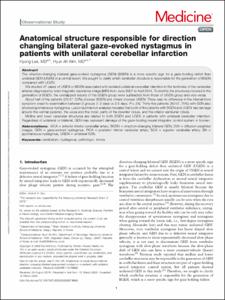Anatomical structure responsible for direction changing bilateral gaze-evoked nystagmus in patients with unilateral cerebellar infarction
- Keimyung Author(s)
- Lee, Hyung
- Department
- Dept. of Neurology (신경과학)
- Journal Title
- Medicine
- Issued Date
- 2020
- Volume
- 99
- Issue
- 17
- Keyword
- cerebellum; nystagmus; pathologic; stroke
- Abstract
- The direction-changing bilateral gaze-evoked nystagmus (GEN) (BGEN) is a more specific sign for a gaze-holding deficit than unilateral GEN (UGEN) in a central lesion. We sought to clarify which cerebellar structure is responsible for the generation of BGEN compared with UGEN.We studied 47 cases of UGEN or BGEN associated with isolated unilateral cerebellar infarction in the territories of the cerebellar arteries diagnosed by brain magnetic resonance image (MRI) from June 2007 to April 2014. To identify the structures involved in the generation of BGEN, the overlapped lesions of the BGEN group were subtracted from those of UGEN group and vice versa.About half of the patients (25/47, 53%) showed BGEN and others showed UGEN. There was no difference in the interval from symptom onset to examination between 2 groups (1.3 days vs 2.5 days, P = .24). Thirty-five patients (35/47, 75%) with GEN also showed spontaneous nystagmus. Lesion subtraction analyses revealed that both of the patients with BGEN and UGEN had damage around the vermal pyramid, the uvula and the tonsil, parts of the biventer lobule, and the inferior semilunar lobule.Midline and lower cerebellar structures are related to both BGEN and UGEN in patients with unilateral cerebellar infarction. Regardless of unilateral or bilateral, GEN may represent damage of the gaze-holding neural integrator control system in human.
- Publisher
- School of Medicine (의과대학)
- Citation
- Hyung Lee and Hyun Ah Kim. (2020). Anatomical structure responsible for direction changing bilateral gaze-evoked nystagmus in patients with unilateral cerebellar infarction. Medicine, 99(17), e19866. doi: 10.1097/MD.0000000000019866
- Type
- Article
- ISSN
- 1536-5964
- Source
- https://journals.lww.com/md-journal/Fulltext/2020/04240/Anatomical_structure_responsible_for_direction.61.aspx
- Appears in Collections:
- 1. School of Medicine (의과대학) > Dept. of Neurology (신경과학)
- 파일 목록
-
-
Download
 oak-2020-0491.pdf
기타 데이터 / 542.06 kB / Adobe PDF
oak-2020-0491.pdf
기타 데이터 / 542.06 kB / Adobe PDF
-
Items in Repository are protected by copyright, with all rights reserved, unless otherwise indicated.